 Articles...
Articles... 
An Ecological Life History of the
Mexican Fritillary on Jamaica
© 2000, Phil Schappert
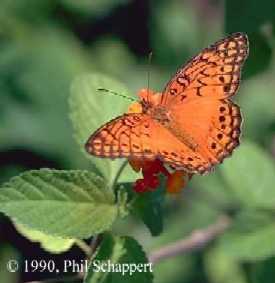 Authors note: The Jamaican subspecies of the Mexican Fritillary,Euptoieta hegesia hegesia (Nymphalidae), is, for readers of the book, a familiar example because it has been my primary research species. In this article I extend the concepts from the fourth chapter, A Butterflies World, into a discussion of the interaction of the various forces and pressures on the immature and adult stages...a gestalt view of the life history that tries to "put it all together." This is part one of two.
Authors note: The Jamaican subspecies of the Mexican Fritillary,Euptoieta hegesia hegesia (Nymphalidae), is, for readers of the book, a familiar example because it has been my primary research species. In this article I extend the concepts from the fourth chapter, A Butterflies World, into a discussion of the interaction of the various forces and pressures on the immature and adult stages...a gestalt view of the life history that tries to "put it all together." This is part one of two.
Part 1
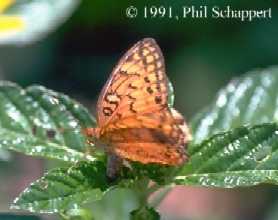 On Jamaica, the Mexican Fritillary uses two different kinds of closely related host plants. Its preferred host is the tropical shrub, Turnera ulmifolia (Turneraceae) but it also uses a variety of passion vines, Passiflora species (especially P. foetida and P. suberosa; Passifloraceae), as alternate hosts. All of these plants contain the same defensive chemistry—which is, of course, not a defense against the Mexican Fritillary—although the preferred host varies for the presence or absence and the strength of the defense. Females lay the majority of their eggs on the preferred host but will readily lay eggs on all four species of passion vines that grow in the same habitat. In captivity, more than 99% of all eggs were laid on the preferred host plant, however, in the wild it is not uncommon to also find eggs and/or caterpillars on alternate hosts.
On Jamaica, the Mexican Fritillary uses two different kinds of closely related host plants. Its preferred host is the tropical shrub, Turnera ulmifolia (Turneraceae) but it also uses a variety of passion vines, Passiflora species (especially P. foetida and P. suberosa; Passifloraceae), as alternate hosts. All of these plants contain the same defensive chemistry—which is, of course, not a defense against the Mexican Fritillary—although the preferred host varies for the presence or absence and the strength of the defense. Females lay the majority of their eggs on the preferred host but will readily lay eggs on all four species of passion vines that grow in the same habitat. In captivity, more than 99% of all eggs were laid on the preferred host plant, however, in the wild it is not uncommon to also find eggs and/or caterpillars on alternate hosts.
The females lay eggs singly but will often, at least on the preferred host, return to oviposit on the same plant. Assuming that she has correctly assessed the best available plant, other females may make the same host choice that she did. The end result is that a host plant that is capable of supporting three or four larvae often has a dozen or more. I have found up to an astounding 42 eggs and caterpillars on a single host plant that could not possibly support anywhere near that many! There also appears to be a pronounced preference for seedlings which, being young, may have more nutritious tissue (and also contain more of the plant's defensive chemical compounds) but this also yields a situation where the caterpillars can, quite literally, eat themselves out of house and home. Whether there are too many larvae on a larger plant or a plant is too small to support a single caterpillar, the end result is the same: partially grown larvae end up having to forage for food – a potentially dangerous situation.
The caterpillars of the Mexican Fritillary feed on the undersides of the leaves of its primary host plant during the first two instars. In the first stage it feeds under the wide leaf blade and is careful not to eat through the leaves entirely. The waxy cuticle of the upperside of the leaf can gum up the mandibles of a small caterpillar and interfere with feeding but, since holes in the leaves can be used as location cues by parasites and predators, it may also be an anti-predator strategy. In its second instar it begins feeding on the edges of the leaves, but, again, only from the underside of the leaf. At this time it is a brick red color with very small, and not very threatening-looking, spines.
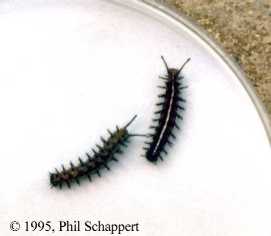 At its second molt it develops two lateral lines, and a dorsal one, that run the length of the body. Each white line is edged on both sides by rows of black dots at the bases of the spines. The background color deepens to maroon and the spines become more predominate: longer and distinctly barbed and threatening in appearance. Interestingly, it's at about this time that the caterpillar changes its feeding strategy from feeding and resting only on the underside of leaves to boldly (or at least far more conspicuously) feeding on the upperside of the leaves. Eventually, the ground color deepens to blood-red, the accent or "racing" stripes become very distinct—with the dotted black edging lines merging into prominent black edge stripes—and the spines become truly nasty looking. In its fifth and final instar it is about 60 mm in length and has become, in my opinion anyway, very unappetizing. I take solace in the fact that a bat, a toad and some Anolis lizards all agreed with me and refused to eat them on sight.
At its second molt it develops two lateral lines, and a dorsal one, that run the length of the body. Each white line is edged on both sides by rows of black dots at the bases of the spines. The background color deepens to maroon and the spines become more predominate: longer and distinctly barbed and threatening in appearance. Interestingly, it's at about this time that the caterpillar changes its feeding strategy from feeding and resting only on the underside of leaves to boldly (or at least far more conspicuously) feeding on the upperside of the leaves. Eventually, the ground color deepens to blood-red, the accent or "racing" stripes become very distinct—with the dotted black edging lines merging into prominent black edge stripes—and the spines become truly nasty looking. In its fifth and final instar it is about 60 mm in length and has become, in my opinion anyway, very unappetizing. I take solace in the fact that a bat, a toad and some Anolis lizards all agreed with me and refused to eat them on sight.
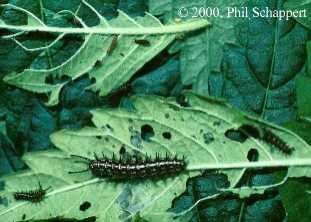 On the preferred host, caterpillars develop faster and reach pupation weight in 12 or 13 days on average (because female butterflies are about 25% larger than males, they take about one day longer to develop than males). On alternative hosts, under identical temperature and humidity conditions, the larvae take longer to develop, usually needing as much as 15 to 18 days on average. One consequence of this timing difference is that the larvae that develop on alternate hosts become larger (and thus yield larger adult butterflies) than those that grow on the preferred host because they feed at the same rate on both hosts. So, you ask, why should this matter? On the one hand, larvae that take longer to grow become larger butterflies but are at a disadvantage because they are vulnerable to predators and parasites of caterpillars for a longer period of time. On the other, caterpillars that grow on the preferred host become smaller butterflies but reduce the amount of time that they are vulnerable to predation. The end results of these size differences, however, are more complicated than it first appears…
On the preferred host, caterpillars develop faster and reach pupation weight in 12 or 13 days on average (because female butterflies are about 25% larger than males, they take about one day longer to develop than males). On alternative hosts, under identical temperature and humidity conditions, the larvae take longer to develop, usually needing as much as 15 to 18 days on average. One consequence of this timing difference is that the larvae that develop on alternate hosts become larger (and thus yield larger adult butterflies) than those that grow on the preferred host because they feed at the same rate on both hosts. So, you ask, why should this matter? On the one hand, larvae that take longer to grow become larger butterflies but are at a disadvantage because they are vulnerable to predators and parasites of caterpillars for a longer period of time. On the other, caterpillars that grow on the preferred host become smaller butterflies but reduce the amount of time that they are vulnerable to predation. The end results of these size differences, however, are more complicated than it first appears…
The Jamaican habitats of Mexican Fritillaries can be characterized as marginal, often raised coral or sandy beaches where their weedy host plants can eke out an existence. Populations of the preferred host plant are separate and distinct while individual plants of the alternate hosts are ephemeral, often widely separated in both space and time. My population studies suggest that butterfly populations are likewise discreet with little interchange of individuals between one host plant population and another, even when the plant populations are only 1 km (0.6 mile) apart. The butterflies visit a diverse array of nectar plants that encompass a broad color spectrum and many flower forms, sometimes even visiting the flowers of their host plants. They are especially active early in the morning making fast, direct flights around and through the habitat but their activity changes markedly later in the day. After about 8 am their flight patterns change to relatively slow, wandering flight within 1 m of the ground. They stop and rest frequently, adopting dorsal basking postures in the morning but changing to closed-wing, shadow reducing postures as the heat of the day builds towards afternoon.
Females often approach a primary host plant, fly around it once or twice, alighting briefly on upper leaves, then descend to within 15 cm (6") of the ground and fly about excitedly. My impression is that they are looking for seedlings. Given a choice females prefer to oviposit on seedlings, however, seedlings are relatively rare in plant populations. At various times I have followed females on oviposition flights and am always curious at the choices that they make. They often alternate visiting up to a half dozen prospective host plants in rapid succession with stopping to rest or nectar at flowers. On average, only 1 in every 6 to 8 plants is considered suitable, yet I am rarely able to discern any apparent differences between acceptable and unacceptable hosts. Intriguingly, females will often make the same choices on successive days: marked, identifiable females will reject the same plants that they rejected on a previous occasion. There is little doubt that females exercise host choice in the wild but when kept in captivity they will readily lay eggs on any provided preferred host.
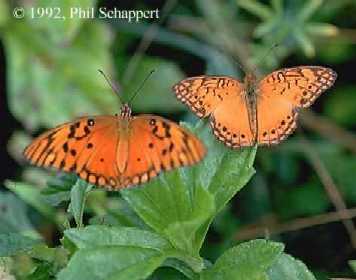 Males patrol the habitat in search of females, often chasing any moving object of about the right size, shape and color. More often than not it's either another male Mexican Fritillary or a butterfly of another species, most notably the similarly colored Gulf Fritillary, Agraulis vanillae (Nymphalidae). They also patrol within 15 to 45 cm (6 to 18") of the ground, presumably looking for resting females. Males are the more active sex and spend more of their time in flight and this is reflected in the male-biased sex ratio in my population studies. Of course, the sex ratio is not really skewed, it just appears to be because the more active males are encountered more frequently during studies. The biased sex ratio is probably also partly explained by slightly reduced "residency time" in females that may be due to either shorter female lifespans or increased emigration.
Males patrol the habitat in search of females, often chasing any moving object of about the right size, shape and color. More often than not it's either another male Mexican Fritillary or a butterfly of another species, most notably the similarly colored Gulf Fritillary, Agraulis vanillae (Nymphalidae). They also patrol within 15 to 45 cm (6 to 18") of the ground, presumably looking for resting females. Males are the more active sex and spend more of their time in flight and this is reflected in the male-biased sex ratio in my population studies. Of course, the sex ratio is not really skewed, it just appears to be because the more active males are encountered more frequently during studies. The biased sex ratio is probably also partly explained by slightly reduced "residency time" in females that may be due to either shorter female lifespans or increased emigration.


